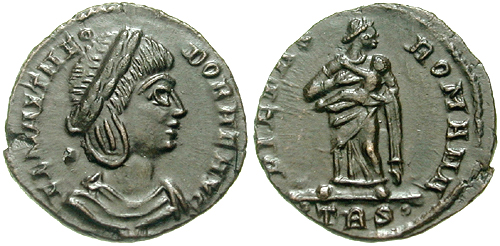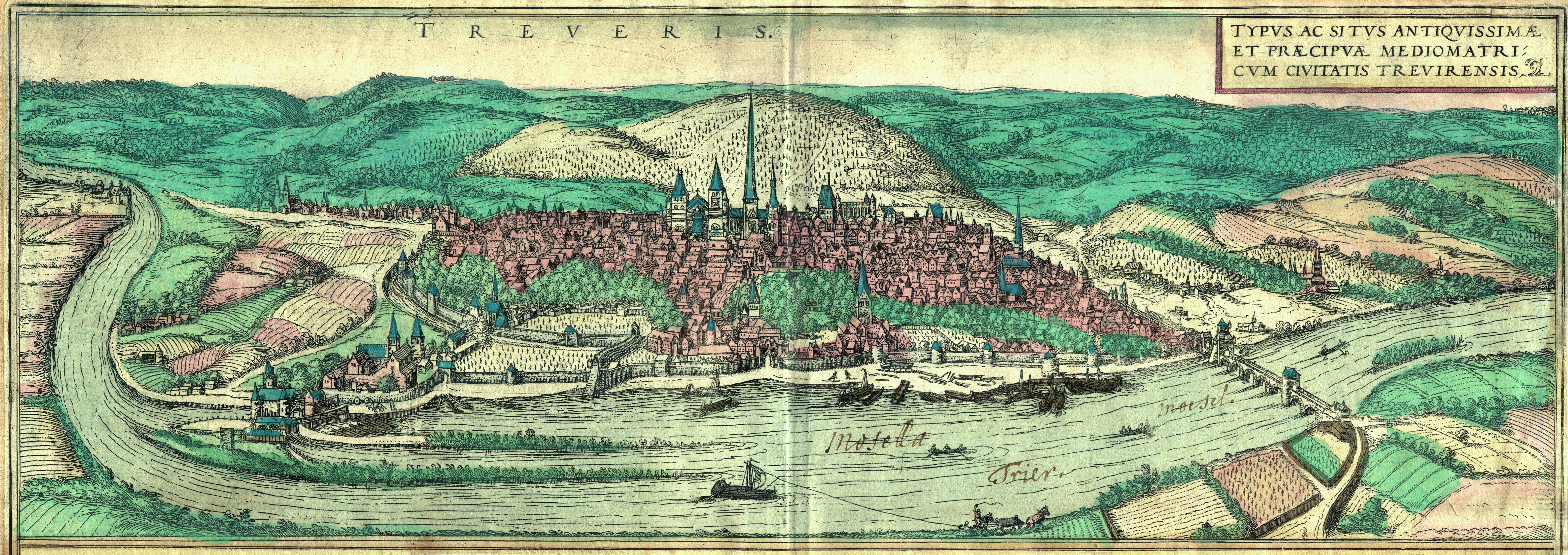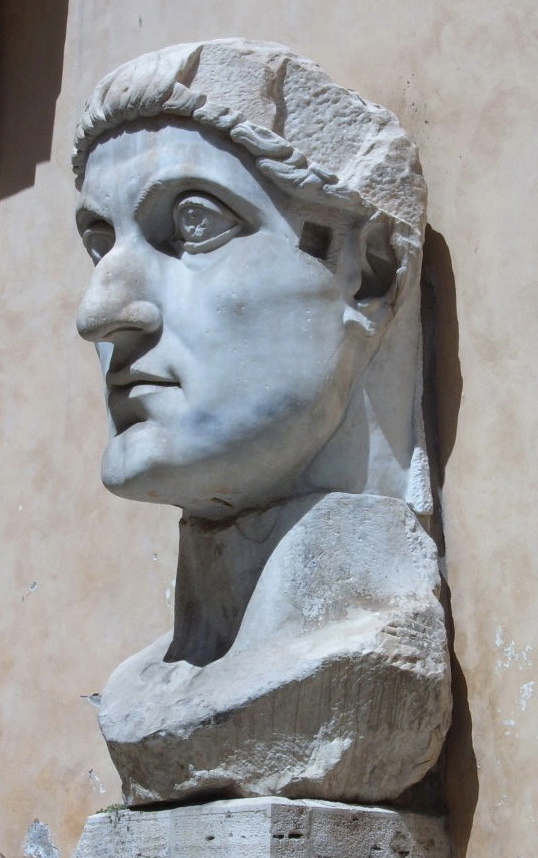|
306
__NOTOC__ Year 306 ( CCCVI) was a common year starting on Tuesday (link will display the full calendar) of the Julian calendar. At the time, it was known as the Year of the Consulship of Constantius and Valerius (or, less frequently, year 1059 '' Ab urbe condita''). The denomination 306 for this year has been used since the early medieval period, when the Anno Domini calendar era became the prevalent method in Europe for naming years. Events By place Roman Empire * July 25 – Constantius I dies outside Eboracum (modern-day York). Constantine, aged 23 or 24, is declared emperor by his troops. Emperor Galerius grants Constantine the title of Caesar, and elevates Flavius Valerius Severus to emperor of the Western Roman Empire. * Constantine institutes toleration of the Christians in his territories. * Constantine establishes his capital in Augusta Treverorum (Trier). He begins a major expansion of the city, strengthening the walls, expanding the palace complex and bu ... [...More Info...] [...Related Items...] OR: [Wikipedia] [Google] [Baidu] |
Constantius I
Flavius Valerius Constantius "Chlorus" ( – 25 July 306), also called Constantius I, was Roman emperor from 305 to 306. He was one of the four original members of the Tetrarchy established by Diocletian, first serving as caesar from 293 to 305 and then ruling as augustus until his death. Constantius was also father of Constantine the Great, the first Christian emperor of Rome. The nickname Chlorus () was first popularized by Byzantine-era historians and not used during the emperor's lifetime. After his re-conquering of Roman Britain, he was given the title 'Redditor Lucis Aeternae', meaning 'The Restorer of Eternal Light'. Of humble origin, Constantius had a distinguished military career and rose to the top ranks of the army. Around 289 he set aside Helena, Constantine's mother, to marry a daughter of Emperor Maximian, and in 293 was added to the imperial college by Maximian's colleague, Diocletian. Assigned to rule Gaul, Constantius defeated the usurper Carausius there an ... [...More Info...] [...Related Items...] OR: [Wikipedia] [Google] [Baidu] |
Maxentius
Marcus Aurelius Valerius Maxentius (c. 283 – 28 October 312) was a Roman emperor, who reigned from 306 until his death in 312. Despite ruling in Italy and North Africa, and having the recognition of the Senate in Rome, he was not recognized as a legitimate emperor by his fellow emperors. He was the son of former Emperor Maximian and the son-in-law of Emperor Galerius. The latter part of his reign was preoccupied with civil war, allying with Maximinus against Licinius and Constantine. The latter defeated him at the Battle of the Milvian Bridge in 312, where Maxentius, with his army in flight, purportedly perished by drowning in the Tiber river. Maxentius was the last emperor to permanently reside in Rome. He attempted to embellish, restore and improve the ancient capital, carrying out important building works, including the Temple of the Divine Romulus (dedicated to his deceased son), the Basilica of Maxentius, which was completed by Constantine, the villa and the circ ... [...More Info...] [...Related Items...] OR: [Wikipedia] [Google] [Baidu] |
Western Roman Empire
The Western Roman Empire comprised the western provinces of the Roman Empire at any time during which they were administered by a separate independent Imperial court; in particular, this term is used in historiography to describe the period from 395 to 476, where there were separate coequal courts dividing the governance of the empire in the Western and the Eastern provinces, with a distinct imperial succession in the separate courts. The terms Western Roman Empire and Eastern Roman Empire were coined in modern times to describe political entities that were '' de facto'' independent; contemporary Romans did not consider the Empire to have been split into two empires but viewed it as a single polity governed by two imperial courts as an administrative expediency. The Western Roman Empire collapsed in 476, and the Western imperial court in Ravenna was formally dissolved by Justinian in 554. The Eastern imperial court survived until 1453. Though the Empire had seen periods ... [...More Info...] [...Related Items...] OR: [Wikipedia] [Google] [Baidu] |
Galerius
Gaius Galerius Valerius Maximianus (; 258 – May 311) was Roman emperor from 305 to 311. During his reign he campaigned, aided by Diocletian, against the Sasanian Empire, sacking their capital Ctesiphon in 299. He also campaigned across the Danube against the Carpi, defeating them in 297 and 300. Although he was a staunch opponent of Christianity, Galerius ended the Diocletianic Persecution when he issued an Edict of Toleration in Serdica in 311. Early life Galerius was born near Serdica, in Dacia Ripensis, later named Dacia Mediterranea, though some modern scholars consider the strategic site where he later built his palace named after his mother – Felix Romuliana ( Gamzigrad) – his birth and funeral place.Barnes, ''New Empire'', p. 37. His father was a Thracian and his mother Romula had left Roman Dacia because of the Carpians' attacks. He originally followed his father's occupation, that of a herdsman, where he was nicknamed "Armentarius", herdsman ( la, armen ... [...More Info...] [...Related Items...] OR: [Wikipedia] [Google] [Baidu] |
Maximian
Maximian ( la, Marcus Aurelius Valerius Maximianus; c. 250 – c. July 310), nicknamed ''Herculius'', was Roman emperor from 286 to 305. He was '' Caesar'' from 285 to 286, then ''Augustus'' from 286 to 305. He shared the latter title with his co-emperor and superior, Diocletian, whose political brain complemented Maximian's military brawn. Maximian established his residence at Trier but spent most of his time on campaign. In late 285, he suppressed rebels in Gaul known as the Bagaudae. From 285 to 288, he fought against Germanic tribes along the Rhine frontier. Together with Diocletian, he launched a scorched earth campaign deep into Alamannic territory in 288, refortifying the frontier. The man he appointed to police the Channel shores, Carausius, rebelled in 286, causing the secession of Britain and northwestern Gaul. Maximian failed to oust Carausius, and his invasion fleet was destroyed by storms in 289 or 290. Maximian's subordinate, Constantius, campaigned against ... [...More Info...] [...Related Items...] OR: [Wikipedia] [Google] [Baidu] |
Flavius Valerius Severus
Flavius Valerius Severus (died September 307), also called Severus II, was a Roman emperor from 306 to 307. After failing to besiege Rome, he fled to Ravenna. It is thought that he was killed there or executed near Rome. Background and early career Severus was of humble birth, born in Northern Illyria around the middle of the third century. A friend of emperor Galerius, he rose to become a senior officer in the Roman army, being nominated as ''caesar'' of the Western Roman Empire. According to Lactantius, Diocletian objected to Galerius's suggestion, saying in response, "What! That dancer, that habitual drunkard who turns night into day and day into night?" Galerius persisted, saying that Severus has served faithfully as paymaster and purveyor of the army.Lactantius (4th century). Lord Hailes (transl.) (2021) On the Deaths of the Persecutors'. Evolution Publishing, Merchantville, NJ , pp. 31-47 Diocletian acquiesced and Severus succeeded to the post of ''caesar'' on 1 May 305 ... [...More Info...] [...Related Items...] OR: [Wikipedia] [Google] [Baidu] |
York
York is a cathedral city with Roman origins, sited at the confluence of the rivers Ouse and Foss in North Yorkshire, England. It is the historic county town of Yorkshire. The city has many historic buildings and other structures, such as a minster, castle, and city walls. It is the largest settlement and the administrative centre of the wider City of York district. The city was founded under the name of Eboracum in 71 AD. It then became the capital of the Roman province of Britannia Inferior, and later of the kingdoms of Deira, Northumbria, and Scandinavian York. In the Middle Ages, it became the northern England ecclesiastical province's centre, and grew as a wool-trading centre. In the 19th century, it became a major railway network hub and confectionery manufacturing centre. During the Second World War, part of the Baedeker Blitz bombed the city; it was less affected by the war than other northern cities, with several historic buildings being gutted and restore ... [...More Info...] [...Related Items...] OR: [Wikipedia] [Google] [Baidu] |
Rome
, established_title = Founded , established_date = 753 BC , founder = King Romulus (legendary) , image_map = Map of comune of Rome (metropolitan city of Capital Rome, region Lazio, Italy).svg , map_caption = The territory of the ''comune'' (''Roma Capitale'', in red) inside the Metropolitan City of Rome (''Città Metropolitana di Roma'', in yellow). The white spot in the centre is Vatican City. , pushpin_map = Italy#Europe , pushpin_map_caption = Location within Italy##Location within Europe , pushpin_relief = yes , coordinates = , coor_pinpoint = , subdivision_type = Country , subdivision_name = Italy , subdivision_type2 = Region , subdivision_name2 = Lazio , subdivision_type3 = Metropolitan city , subdivision_name3 = Rome Capital , government_footnotes= , government_type = Strong Mayor–Council , leader_title2 = Legislature , leader_name2 = Capitoline Assembl ... [...More Info...] [...Related Items...] OR: [Wikipedia] [Google] [Baidu] |
July 25
Events Pre-1600 * 306 – Constantine I is proclaimed Roman emperor by his troops. * 315 – The Arch of Constantine is completed near the Colosseum in Rome to commemorate Constantine I's victory over Maxentius at the Milvian Bridge. * 677 – Climax of the Siege of Thessalonica by the Slavs in a three-day assault on the city walls. * 864 – The Edict of Pistres of Charles the Bald orders defensive measures against the Vikings. *1137 – Eleanor of Aquitaine marries Prince Louis, later King Louis VII of France, at the Cathedral of Saint-André in Bordeaux. * 1139 – Battle of Ourique: The Almoravids, led by Ali ibn Yusuf, are defeated by Prince Afonso Henriques who is proclaimed King of Portugal. * 1261 – The city of Constantinople is recaptured by Nicaean forces under the command of Alexios Strategopoulos, re-establishing the Byzantine Empire. *1278 – The naval Battle of Algeciras takes place in the context of the Spanish Reconqu ... [...More Info...] [...Related Items...] OR: [Wikipedia] [Google] [Baidu] |
Caesar (title)
Caesar ( English Caesars; Latin ''Caesares''; in Greek: ''Kaîsar'') is a title of imperial character. It derives from the ''cognomen'' of Julius Caesar, a Roman dictator. The change from being a familial name to a title adopted by the Roman emperors can be traced to AD 68, following the fall of the Julio–Claudian dynasty. Origins The first known individual to bear the ''cognomen'' of "Caesar" was Sextus Julius Caesar, who is likewise believed to be the common ancestor of all subsequent Julii Caesares. Sextus' great-grandson was the dictator Gaius Julius Caesar. After he seized control of the Roman Republic following his war against the Senate, he adopted the title of ''dictator perpetuo'' ("dictator in perpetuity"), a title he only held for about a month before he was assassinated in 44 BC. Julius Caesar's death did not lead to the restoration of the Republic, and instead led to the rise of the Second Triumvirate, composed by three dictators including Ju ... [...More Info...] [...Related Items...] OR: [Wikipedia] [Google] [Baidu] |
History Of Trier
Trier in Rhineland-Palatinate, whose history dates to the Roman Empire, is often claimed to be the oldest city in Germany. Traditionally it was known in English by its French name of Treves. Prehistory The first traces of human settlement in the area of the city show evidence of linear pottery settlements dating from the early Neolithic period. Since the last pre-Christian centuries, members of the Celtic tribe of the Treveri settled in the area of today's Trier. Roman Empire The Romans under Julius Caesar first subdued the Treveri in 58 to 50 BC. No later than 16 BC, at the foot of the hill later christened the Petrisberg, upon which a military camp had been set up in 30 BC and abandoned again a few months later, the Romans founded the city of ("City of Augustus in the land of the Treveri"), which has a claim to being the oldest city in Germany. The honour of being named after the Emperor was only locally shared by Augsburg and Augst in northern Switzerland. Followi ... [...More Info...] [...Related Items...] OR: [Wikipedia] [Google] [Baidu] |
Eboracum
Eboracum () was a fort and later a city in the Roman province of Britannia. In its prime it was the largest town in northern Britain and a provincial capital. The site remained occupied after the decline of the Western Roman Empire and ultimately developed into the present-day city York, occupying the same site in North Yorkshire, England. Two Roman emperors died in Eboracum: Septimius Severus in 211 AD, and Constantius Chlorus in 306 AD. Etymology The first known recorded mention of Eboracum by name is dated , and is an address containing the genitive form of the settlement's name, ''Eburaci'', on a wooden stylus tablet from the Roman fortress of Vindolanda in what is now the modern Northumberland. During the Roman period, the name was written both ''Eboracum'' and ''Eburacum'' (in nominative form). The name ''Eboracum'' comes from the Common Brittonic ''*Eburākon'', which means "yew tree place". The word for "yew" was ''*ebura'' in Proto-Celtic (cf. Old Irish '' ... [...More Info...] [...Related Items...] OR: [Wikipedia] [Google] [Baidu] |



_-_Foto_G._Dall'Orto_28-5-2006.jpg)




